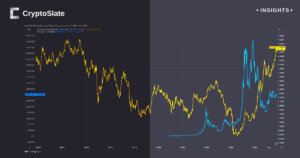Ad
Retail Sales
Source: FRED
What is Retail Sales?
Retail sales are one of the most critical indicators of consumer behavior and economic health. They represent the total value of goods sold to consumers by businesses, providing insight into how much individuals are spending on a monthly or quarterly basis.
This metric plays a vital role in understanding the broader economic trends, as consumer spending drives a significant portion of economic activity, especially in countries like the United States. For those in traditional and crypto markets, tracking retail sales can offer valuable clues into potential shifts in market sentiment and even asset prices.
History and Overview of Retail Sales
The concept of retail sales, in its modern form, has its roots in the development of large-scale consumer economies in the 20th century, particularly in the United States. In 1930, the U.S. Census Bureau began conducting the “Monthly Retail Trade Survey” to track retail sales, which became a critical barometer for government agencies, businesses, and investors alike.
Over time, as global markets grew and economies became more intertwined, the importance of tracking retail sales expanded to other major economies, including Europe, China, and Japan.
The evolution of retail sales data collection reflects broader economic shifts, from an agricultural-based economy to one centered on industrial production, and finally to the service and digital economy of today. Online retail sales, a relatively new phenomenon compared to brick-and-mortar shopping, have also surged in recent decades, largely due to the rise of companies like Amazon, Alibaba, and Shopify. E-commerce has revolutionized how consumers shop, adding complexity to the way retail sales are tracked and analyzed.
Today, national governments and institutions like the U.S. Federal Reserve or the European Central Bank consider retail sales one of the most reliable indicators for economic forecasting. A rise in retail sales often signals strong consumer confidence and economic growth, while a drop can suggest reduced consumer spending power, potentially hinting at economic slowdowns or recessions.
Components of Retail Sales
Retail sales cover a broad spectrum of consumer goods, including:
- Durable Goods: These include items such as cars, appliances, and electronics—goods that have a long life span.
- Non-Durable Goods: These are goods that are consumed quickly, such as food, clothing, and fuel.
- E-commerce: The increasing portion of retail sales conducted online through platforms like Amazon or Alibaba.
Data is typically collected on a monthly basis and analyzed in two ways: nominal retail sales (the total dollar amount) and real retail sales (adjusted for inflation). Both metrics offer unique insights, but real retail sales tend to be more critical in understanding actual economic activity.
Why Retail Sales Matter
Retail sales data is a crucial metric for both economists and investors because consumer spending accounts for a substantial portion of GDP in many economies. In the United States, consumer spending represents roughly 70% of the GDP. Therefore, fluctuations in retail sales data can be a leading indicator of broader economic trends, signaling expansions or contractions in the business cycle.
For businesses, especially retailers and manufacturers, understanding retail sales trends helps in adjusting their supply chains, managing inventories, and forecasting future demand. A surge in retail sales might encourage businesses to ramp up production, while a decline could lead to cutbacks and layoffs.
How Retail Sales Correlate with Bitcoin and Crypto Markets
Although retail sales are a traditional economic indicator, their relationship with Bitcoin and crypto markets has been an area of increasing interest in recent years. Crypto markets operate in a different financial paradigm, one that is often more influenced by technological innovation, macroeconomic policy, and speculative activity. However, there are several ways in which retail sales can impact Bitcoin and the broader crypto market:
- Disposable Income and Speculative Investment: When retail sales are high, it often indicates that consumers have more disposable income. Some of this disposable income can flow into speculative investments like Bitcoin. During periods of strong retail growth, more individuals might be willing to take risks in volatile markets such as crypto, potentially driving up Bitcoin prices.
- Economic Uncertainty: On the flip side, a significant decline in retail sales may indicate economic distress or uncertainty. Interestingly, in times of economic downturns, Bitcoin and other cryptos are sometimes seen as a “safe haven” asset, similar to gold. For example, during the COVID-19 pandemic, retail sales plummeted due to lockdowns, but Bitcoin’s price surged, partly due to concerns over fiat currency inflation and economic instability.
- Inflation Concerns: Retail sales data can also serve as a proxy for inflation. If retail prices rise significantly due to inflation, consumers may spend less on traditional goods, opting instead to invest in assets that can hedge against inflation, like Bitcoin. The narrative around Bitcoin as “digital gold” has gained traction, especially during periods of rising inflationary pressures. As retail sales data contributes to inflationary forecasts, it can indirectly influence investor sentiment in crypto markets.
- Institutional Investment Tied to Consumer Behavior: With the rise of institutional interest in Bitcoin, especially with companies like MicroStrategy and Tesla adding Bitcoin to their balance sheets, retail sales and consumer behavior could have a more pronounced effect on crypto markets. If consumer confidence dips and traditional equities falter, it could lead to institutional rebalancing, where more capital is allocated into alternative assets like Bitcoin.
Conclusion
Retail sales remain one of the most essential indicators of economic health, influencing everything from government policy to business decisions. While traditionally associated with consumer spending in the broader economy, its impact on crypto markets like Bitcoin is becoming more evident.
Understanding how retail sales data intertwines with disposable income, inflation, and institutional behavior offers valuable insights into the dynamic relationship between traditional finance and digital assets. For those interested in both sectors, tracking retail sales could be a powerful tool for anticipating future market trends, not just in traditional markets but in crypto as well.




































































